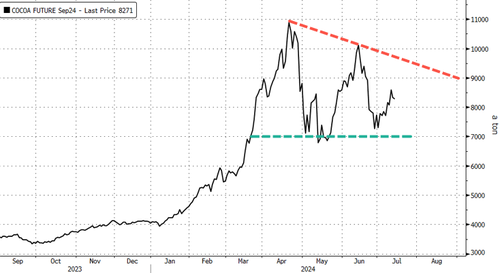Cocoa Traders Face Billion Dollar Loss As Ghana Throttles Cocoa Delivery Supplies, Report Says
Major trading houses risk losing over a billion dollars on cocoa derivatives after top producer Ghana failed to deliver beans this season due to adverse weather conditions that significantly tightened global supplies, forcing traders to liquidate short positions into a mega squeeze earlier this year.
In April, the Ghana Cocoa Board spoke with major commodity traders about delaying the delivery of hundreds of thousands of tons of cocoa beans until the next growing season due to dwindling bean supplies.
Reuters reported that the board is preparing to delay upwards of 350,000 metric tons of the bean this season, citing six industry insiders who are familiar with the situation. This is about half of the cocoa beans usually sold in a season.
The losses from delivery delays could exceed $4,000 a ton on the cocoa futures market for traders and processors, translating into a total loss of about $1.4 billion.
“We’re sitting staring at our screens, barely trading,” the head cocoa trader at a global trading house told Reuters, speaking anonymously, adding the global cocoa physical and futures market has ground to a halt due to the volatility.
Trading houses like Cargill and Barry Callebaut use the futures market to hedge or secure cocoa prices.
Reuters provided more color on just how failed bean deliveries can be catastrophic for major trading houses:
Traders typically sign deals to buy beans – like any other commodity – months in advance in the hope of reselling later at a profit. By doing so they take a so called long position in the physical market.
As they wait for the physical commodity to be delivered for weeks or months they need to protect themselves against possible price falls. They typically do this by taking short positions in the futures market to protect against losses on a long position.
Short trading bets on price falls so when the physical commodity arrives, long and short positions cancel each other out, guaranteeing a fixed price.
The strategy unravels, however, if physical delivery – in this case cocoa beans – is delayed in a rallying market.
If this happens, traders are forced to liquidate short positions for the month they had expected the commodity to arrive and take a new short position for the month of a new expected delivery.
Here are some examples of the losses:
Doing so in April 2024 – after the market realised Ghana would delay bean delivery to 2025 – would have been costly, according to the traders.
The six sources said last year traders who bought physical beans for May 2024 delivery would have taken equivalent short positions in May 2024 futures at around $3,000 a ton.
With the market rallying in April 2024, those traders had to liquidate May 2024 shorts – or buy the futures back – at $11,000 a ton, facing losses of $8,000 a ton.
As traders still hope to get the cocoa and need to protect themselves in the physical market, they had to take on new short positions for May 2025 delivery, which in April 2024 traded around $7,000 a ton.
That means that if and when traders get their physical cocoa next May at $3,000 a ton, they will still face an aggregate loss of $4,000 per ton.
In New York, cocoa futures are slightly lower in the morning session, down about 1.5% to $8,222 a ton. As we’ve noted in recent weeks, prices have been oscillating between the support and resistance levels of a triangle pattern.
The Reuters report provides some sense of the losses that stemmed from the short squeeze several months ago. Some traders, such as famed commodity trader Pierre Andurand, still believe prices could rise to $20,000 a ton.
Tyler Durden
Mon, 07/15/2024 – 14:25

